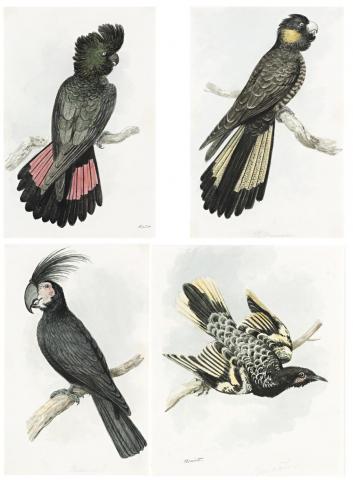A RARE GROUP OF FOUR EARLY WATERCOLOURS OF AUSTRALIAN BIRDS, c.1812
SAMUEL HOWITT
(I) RED-TAILED BLACK COCKATOO, CALYPTORHYNCHUS MAGNIFICUS
watercolour on paper
17.0 x 11.0 cm
signed lower right: Howitt
(II) YELLOW-TAILED BLACK COCKATOO, CALYPTORHYNCHUS FUNEREUS
watercolour on paper
17.0 x 11.0 cm
signed centre right: Howitt
(III) PALM COCKATOO, PROBOSCIGER ATERRIMUS
watercolour on paper
17.5 x 11.0 cm
(IV) REGENT HONEYEATER, XANTHOMYZA PHRYGIA
watercolour on paper
14.0 cm x 11.5 cm
signed lower left: Howitt
Family of the artist, United Kingdom
Thence by descent
Private collection, United Kingdom
Private collection, United Kingdom, acquired from the above mid-1990s
Private collection, Adelaide
Exhibiting in London from the 1780s, Samuel Howitt was an artist and illustrator who specialised in natural history and sporting subjects. His art was closely associated with Thomas Rowlandson, the pre-eminent English caricaturist and artist of the period, whose sister he married. He sketched at the Royal Menagerie in the Tower of London as well as for some of the great private zoos and natural history collections assembled at the time. Two of Howitt's most important turn-of-the-century patrons were William Bullock and Walter Fawkes.
William Bullock (c1773 - 1849) was a major collector and dealer in natural history items from around the world. From his Museum of Natural Curiosities established in Sheffield in the late 1790s he progressed to a major new London private natural history museum open to the public in 1812, The Egyptian Hall, Piccadilly. His collection displayed a wide range of artefacts and specimens and included items sourced from James Cook's voyages. The publication A Companion to Bullock's Museum 1799 includes 'two beautiful unknown parrots from Botany Bay' and 'The Laraquet (sic) of Botany Bay one of the finest birds of the kind in the world' along with other Australian related items.1 Samuel Howitt was to find in this collection an amazing array of animals to draw and Bullock employed him to make sketches for many years. In Bullock's 1808 Companion the last page displays an advertisement for a natural history book that Howitt would be illustrating. Howitt's 1814 Royal Academy exhibition entry gives the artist's residence as Bullock's Museum, Piccadilly.
Walter Fawkes (1769 - 1825), of Farnley Hall near Leeds, Yorkshire was another major collector of natural history and birds in particular. He is renowned in ornithological circles for the five volume album Ornithological Collection which was illustrated by several artists including his close friend J.M.W. Turner and Howitt. This collection was broken up in later years and it is assumed that the collection of 71 Howitt watercolours now held in the Rothschild's Library at the British Natural History Museum, Tring, Hertfordshire were part of Fawkes' collection.
Samuel Howitt illustrated or contributed illustrations to many books such as Miscellaneous Etchings of Animals (1803), Oriental Field Sports (1807), and Ormes' Foreign Field Sports (1813) that also contained a supplement on the Field Sports of Australia depicting Australian Aborigines.
Howitt was recognised for his lively and accurate depictions of natural history specimens and this is well demonstrated in the four works presented here. The four birds Howitt has illustrated, the Red-Tailed Black Cockatoo, Yellow-Tailed Black Cockatoo, Palm Cockatoo and Regent Honeyeater are now all considered to be endangered species.
1. Bullock, W., A Companion to Bullock's Museum, London, 1799
